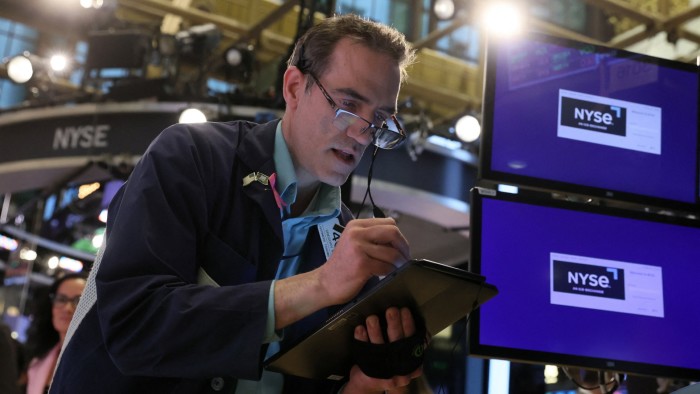DWS Xtrackers stages largest ETF launch in history

Simply sign up to the Exchange traded funds myFT Digest -- delivered directly to your inbox.
Latest news on ETFs
Visit our ETF Hub to find out more and to explore our in-depth data and comparison tools
DWS Xtrackers is staging the largest exchange traded fund launch of all time, as its MSCI USA Climate Action Equity ETF (USCA) begins trading with $2bn of assets.
The listing on the New York stock exchange on Wednesday is backed by anchor investor Ilmarinen, a Finnish insurer, which is providing the initial capital.
It will soar past the previous record for the largest global ETF launch, held by the Goldman Sachs MarketBeta US 1000 Equity ETF (GUSA), which debuted with $1.35bn in April 2022 from its in-house advisory models.
This overtook BlackRock’s US Carbon Transition Readiness ETF (LCTU), which launched with $1.2bn from a consortium of investors including the California State Teachers’ Retirement System (Calsters), Temasek and FM Global in April 2021.
In terms of raising assets from the market, rather than via anchor investors, the most successful launch has been the ProShares Bitcoin Strategy ETF (BITO), which passed the $1bn mark on its second day of trading in October 2021, and saw $1.6bn of inflows in its first week, according to data from VettaFi, a US consultancy.
“This is a key milestone. In the US there is a negative sentiment building towards environmentally friendly ETFs. A successful launch with the support of a large institutional investor to a targeted approach can be a factual counterpoint that might shift the narrative,” said Todd Rosenbluth, head of research at VettaFi.
USCA will hold large and mid-cap US-listed companies that “are leading their sector peers in taking actions relating to climate transition”.
The passive fund, with an expense ratio of 0.07 per cent, will invest in the top 50 per cent of companies within each industry sector based on their emissions intensity, emissions reduction commitments, climate risk management and revenue from greener businesses. The underlying MSCI index was created at the behest of Ilmarinen and DWS.
“US investors considering how to lower their carbon emissions over the long term are looking for best-in-class, forward-looking strategies that align with their objectives,” said Arne Noack, head of systematic investment solutions, Americas at DWS.
The money is not new to the ETF market, however. Ilmarinen is switching it from the $3.2bn Xtrackers MSCI USA ESG Leaders Equity ETF (USSG). This is a broader best-in-class, sector neutral fund that targets ESG in the round, rather than purely climate factors.
“We published in 2020 our portfolio Net Zero 2035 target. Because of this ambitious target we have established asset class-specific road maps. This is part of that,” said Karoliina Lindroos, head of responsible investment at Ilmarinen.
“It’s a little bit similar to a carbon transition or Paris-aligned benchmark, but with sector neutrality. We understand that all the sectors are needed in the economy and we understand there has to be a transition in all sectors.”
Juha Venäläinen, senior portfolio manager at Ilmarinen, which has €56bn of assets under management, said that, while it is impossible to know how stocks will perform in advance, “going forward the climate fight is getting fiercer and fiercer. Companies that are worse than their peers [in climate terms] will face the cost headwinds from not being able to be as good as their peers.”
Latest news on ETFs

Visit the ETF Hub to find out more and to explore our in-depth data and comparison tools helping you to understand everything from performance to ESG ratings
Rosenbluth said the move was part of a wider trend of “asset managers moving away from broad ESG strategies and offering more products focused on climate change and environmental factors . . . the factors that investors might care more about”.
The sheer size of USCA at launch is likely to help it stand out, Rosenbluth added as “it will come on the radar for other investors”, particularly institutions that will only invest in funds that have passed a minimum size threshold.
“There are new ETFs coming to market on a weekly basis and it’s hard to stand out, so for investors who are looking through the new inventory of ETFs a product that has very quickly crossed a key asset milestone, it will put the fund on investors’ radar,” he added. “It doesn’t mean that they will buy it, but it gets through the filters.”
Frankfurt-based DWS currently has 14 US-listed climate-related and ESG ETFs with combined assets of $4.5bn, just under a quarter of Xtrackers’ overall US AUM of $19.1bn. Globally, Xtrackers manages $144bn and DWS €821bn.
Dirk Goergen, chief executive of DWS Americas, said the launch demonstrated its ability to “partner with top institutional investors to create bespoke client-led solutions”.
Launching with a large volume of assets is no guarantee of success, however.
GUSA’s assets have dipped to $1.25bn since launch, although market falls will have played a factor in that. LCTU is today little larger than at its launch, at $1.38bn.
“[LCTU] came to market largely funded. I don’t think it’s really seen inflows at all,” said Rosenbluth. “In nearly two years since the product launched it has gathered $178mn,” he added, citing VettaFi figures.
“It’s got anchor institutional investors that have stayed loyal but the fund hasn’t received broader investor adoption,” Rosenbluth added.
BlackRock’s sister World ex US Carbon Transition Readiness ETF (LCTD) debuted with a further $500mn on the same day, but today boasts assets of just $468mn.
Meanwhile BITO is back down to $943mn, not helped by mark-to-market losses of 56 per cent since inception.

Comments